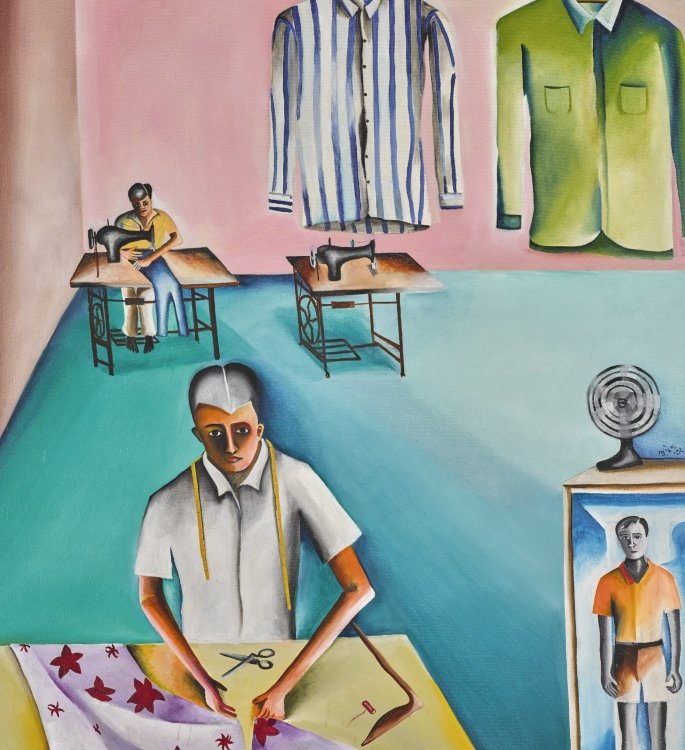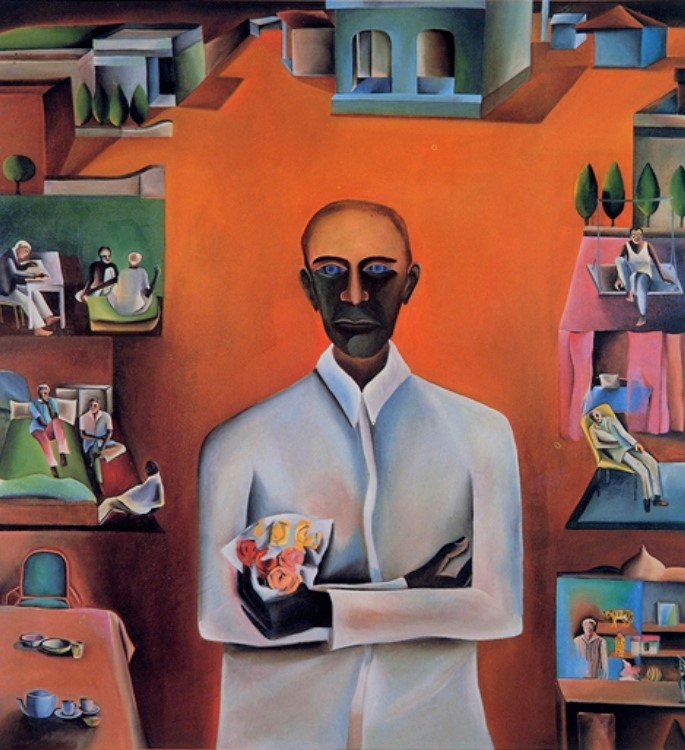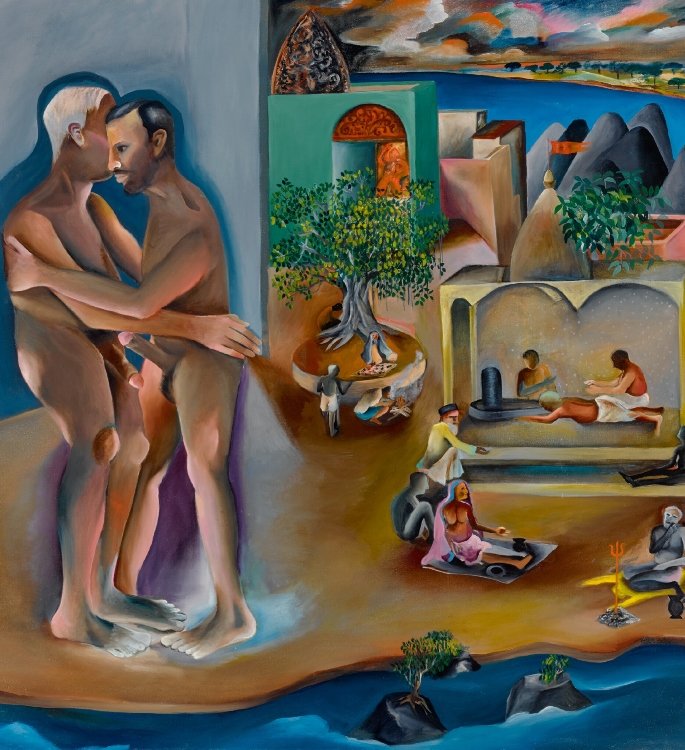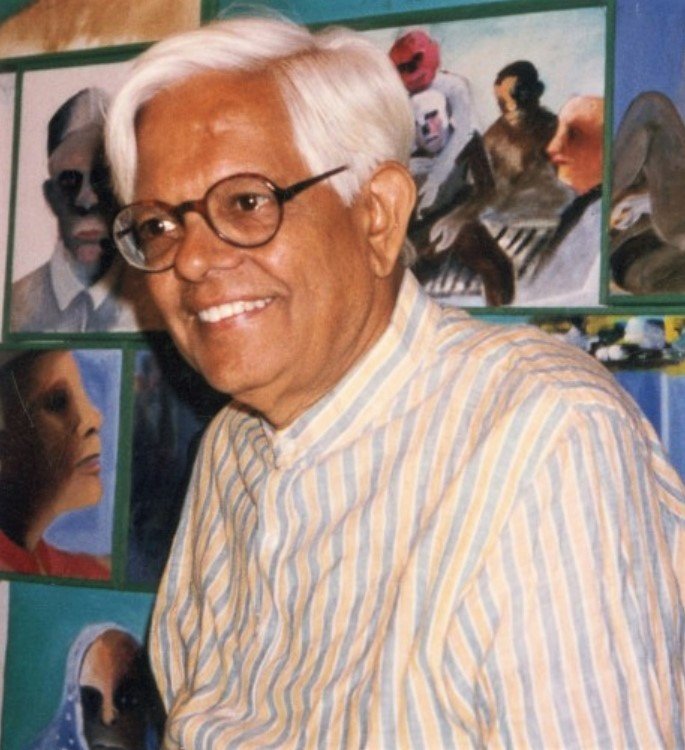5 Top Paintings by Indian Artist Bhupen Khakhar
Numerous amazing artists and illustrators emerge from South Asia but there are not many quite like Bhupen Khakhar.
Born on March 10, 1934, in Bombay, India, Khakhar was a self-taught painter but started his career relatively late.
Originally, Khakhar was on track to become a Chartered Accountant (CA). He was the first person from his family to attend the University of Bombay.
Whilst his artwork was more of a hobby, he was an extremely ambitious person always looking to grow.
In his spare time, Khakhar enhanced his understandings of literature, visual art and Hindu mythology.
It was in 1958 when Khakhar met Gujrati poet and painter, Ghulam Mohammed Sheikh, which motivated the artist to pursue his artistic interest.
The Sheikh urged Khakhar to join the Faculty of Fine Arts in Baroda, an alternative from traditional schools, which promoted contemporary art.
This decision was critical as the faculty was fresh, modern and promoted free thought, which Khakhar thrived within.
At this point, the painter’s artistic style was already apparent. His mystical use of watercolours, vibrant oils and bold figuration created eery portrayals of India.
Most of Khakhar’s work explains the cultural landscape through his lens. His paintings are so assuring in depicting human fragility and the metropolis.
Frances Belsham is a cataloguer for fine arts company, Sotheby’s. He affirmed Khakhar’s visionary talents by describing his work as:
“Depicting the mundane with the imaginary, the sacred with the profane, to weave an idiom, unambiguously his own.”
However, it is not just the spirited nature of Khakhar, which makes him so iconic. In fact, Khakhar was an openly gay painter.
His interactions with British artist, Sir Howard Hodgkin, were especially impactful.
In the 70s, during his stints with Hodgkin in the UK, Khakhar witnessed the growing acceptance of homosexuality.
His own upbringing condemned his sexuality, which meant Khakar only officially announced he was gay after the death of his mother in 1980.
With this, it became a focal feature in his work. This was groundbreaking as it made Khakhar the first Indian artist to freely disclose his sexuality through his work.
Therefore, not only were his paintings fabulous and vibrant, but his stance as a creative was revolutionary.
Bhupen Khakhar’s pieces were impeccably reflective of the world around him.
Besides exploring Indian culture, his paintings were heavily relying on themes of identity, emptiness and freedom.
DESIblitz celebrates Bhupen Khakhar talents and looks at his most mesmerising paintings.
‘De-Luxe Tailors’


De-Luxe Tailors is a masterpiece that epitomises ordinary suburban life through the occupations of normal people.
Bhupen Khakhar was head over heels for capturing the reality of India and the people who make it tick. So, in 1972, he created this illustration to do exactly that.
It was a part of his Tradesmen series which included two other iconic pieces, Janata Watch Repairing and Barber Shop.
All three paintings personified how observant Khakhar was. His work was about everything and everyone.
The artist committed to telling everyone’s stories, no matter where they stood on the economic, political or social scale.
What made De-Luxe Tailors and the Tradesmen series particularly special was its depiction of men doing regular vocations.
Within the history of Indian art, males were rarely the subject of paintings but Khakhar went against this tradition.
Millions of men who are barbers, tailors and watch repairers become lost in the margins of India. However, Khakhar represented them through his work.
Not only was this surprising to see, but he illustrated them with such conviction.
The mundane expression on the tailors face, the dynamic lighting and the gaudy aesthetics are hypnotic.
The way Khakhar uses bright block colours grabs your attention. Moreover, he utilises shading in a way that creates thought-provoking darkness.
Like most of Khakhar’s work, one can interpret it as a whole, especially by looking at the different components within the painting.
For example, in De-Luxe Tailors, there are two pieces of clothing hanging in the top right corner. Of course, this showcases the occupation but it also illustrates how stagnant business can be in India.
Additionally, Khakhar paints one small fan to highlight the working conditions during the 70s, which has not progressed too far since.
Diving deeper into the painting, there are two tailors clearly honing in on their tasks. However, one sewing machine is without a tailor and there is a frozen figure in the bottom right of the canvas.
This could just mirror a mannequin, although, it could symbolise a sense of imprisonment. India boasts such an array of people, many of whom have to survive on the basics just to get by.
Therefore, they work countless hours to have some sense of fulfilment but also risk becoming trapped.
So, it is easy to see how this painting remains so significant. It defied previous ideologies and gave representation to more men in ‘normal’ jobs, but also emphasised India’s economic fight.
‘Man with a Bouquet of Plastic Flowers’


Man with a Bouquet of Plastic Flowers is a startling creation from 1976. The main figure in the painting is anonymous yet takes centre stage.
One of the most prominent avenues that Bhupen Khakhar explored in his art was the idea of solitude. In a lot of the painters work, figures are expressionless and look oblivious to the world around them.
However, this is a direct correlation to Khakhar’s infatuation with portraying the everyday life of the middle class.
Clasping onto a bouquet of roses, the man is discoloured and nonchalant. This is a prominent contrast as flowers are usually associated with celebration and joy.
What is even more intriguing are the surrounding panels. Some depict intimacy whilst others emphasise loneliness and tension.
Also, the use of oranges, reds and browns provide a culturally rich canvas that oozes with the enriching warmth of India.
Although, the sharp edges, smudged facial features and bleakness of the painting is a compelling portrayal of community struggles.
Interestingly, some admirers assume each panel is taken from Khakhar’s life experiences.
The separation of figures could represent the dissolution of his family relationships. Whereas the emptiness of other areas can symbolise the death of his mother.
More importantly, each panel can illustrate Khakhar’s clashing thoughts about self-identity.
Should he suppress his true self to maintain relationships or protest against backward ideas and risk a life of alienation?
Dr Devika Singh, a scholar at the Centre of South Asian Studies, declared:
“There’s an emptiness to the interiors and the small figures are shown as languid in a way that suggests that they’re disengaged from the outside world.”
Undoubtedly, Man with a Bouquet of Plastic Flowers is a vivid look into Khakhar’s mindset and vision as an artist. The painting as a whole represents the contrast of life.
The sombre attitude of each element emphasises how we are all at the forefront of our own stories but can become engulfed by society or our emotions.
Although this is the foundation of Khakhar’s work, it is open to numerous interpretations, which highlights his talents.
‘You Can’t Please All’


Perhaps the most prolific painting that Bhupen Khakhar created was his 1981 piece, You Can’t Please All.
Many critics, fans and historians note this as a ‘coming out’ statement for Khakhar.
The artist knew of his sexual orientation from an early age. However, it was his experiences in Britain that changed his understanding of homosexuality.
One could argue that Khakhar’s previous work explored same-sex relationships. Having said that it was this confessional painting that confirmed his true identity.
Moreover, the actual piece is exceptional and captivating. There are so many aspects that cover the idea of belonging, openness and curiosity.
A life-sized naked man on a balcony dominates the composition as he overlooks the scenes below.
It is proposed that the main figure is glaring at a scene from The miller, his son and the donkey, one of Aesop’s Fables.
These are fictional tales credited to Greek storyteller, Aesop. These use forces of nature within folktales to lead to a moral lesson.
The miller, his son and the donkey concerns itself with a man and his son who always receive criticism from passers-by for how they treat their donkey.
The message behind this fable is that everyone has an opinion and it’s impossible to satisfy all. Hence, it is clearcut how this meaning would be relevant in You Can’t Please All.
The lead figure represents Khakhar overseeing the judgments of the people who represent society. Their accusations are reminiscent of how communities would treat Khakhar as an openly gay man.
Historian, Michelle Standley, cleverly states that the painting is “a subtle embodiment of the desire to both hide from and participate in society.”
Furthermore, the colour palette used evokes a welcoming intimacy.
The cool blues, bold greens and glimmers of yellow achieve a sense of twilight.
Although Khakhar includes his signature use of solid shapes and lines, this iconic piece has more flow and togetherness.
The house interiors, missing car doors and incomplete balcony boast an openness, symbolising the artists’ relief in coming out as a gay man.
The warmth of the canvas is illuminating and Khakhar does extremely well in blending the line between privacy and the public world.
This confession, narration and commentary on his own sexuality were shocking for its time. But, it catapulted the artist into the limelight.
His daring nature changed the Indian artistic landscape forever.
‘Two Men In Benares’


Khakhar’s 1982 painting, Two Men In Benares, is perhaps the most explicit of the artist’s catalogue.
Whilst this focuses on sexuality again, the piece was the start of Khakhar’s journey to reenvision the iconography of homosexual love.
The creative mogul always challenged Indian society and how it changed after the British Raj. He explicitly revealed more about this during an interview in 2003:
“It is the British Raj and our Victorian inheritance that has made us timid.
“At a certain stage in our history, the British made us feel ashamed of our sexuality, of our society’s traditionally more open approach to body and sex.
“This has now made us into a nation of hypocrites.”
In Two Men in Benares, two giant naked figures grasp each other, one of whom is supposedly Khakhar due to his grey hair.
Benares, renamed Varanasi, is a city on the banks of the River Ganges.
It is one of the most sacred cities in India, yet Khakhar’s painting does not aim to disrespect this, but rather embrace it.
The men have a distinct midnight blue surrounding them, which slowly transitions into sharp purple hues towards their toes.
The two figures seem vulnerable yet safe in each other’s arms and the use of these colours is evidently powerful.
The striking use of erect penises emphasises affection. However, as they barely touch, it could represent the lack of acceptance from society.
Interestingly, the composition also celebrates the enriching scenery of Benares.
The dynamic nature, open fires and serene flow of the River Ganges gorgeously encompass the lovers.
The calmness of the image is magnificent but illustrates the power of attraction and how Khakhar views the world.
Stripping away hierarchy and caste, the artist succeeds in accentuating the varying people that make India up.
The fact that the two men and the daily activities are separated by a wall represents isolation yet involvement in the public domain.
They are in the dark and on the periphery and this element makes Two Men In Benares a magical exploration of reality.
‘Idiot’


In 1998, Bhupen Khakhar was sadly diagnosed with prostate cancer and it became the running theme of his work.
The artist had a certain wit and honesty that he evoked through his paintings. This was heightened after his diagnosis as he continued to employ dry humour to tackle the difficult period.
However, as his illness progressed, one saw a change in the tone of the artist’s pieces. Whilst they are still unapologetically raw, they are darker.
Addressing themes of mortality and ageing, Idiot is starkly different from Khakhar’s other work.
Using an entirely golden colour palette with blurred smudges of black, white and grey, the painting is an intense look into Khakhar’s internal struggles.
It focuses on two men, one of which is exposed and urinating into his shoe. The other figure is sitting down pointing towards the man and sniggering.
What’s incredibly dominant here are the expressions on the faces.
As previously mentioned, most of the figures within Khakhar’s work are emotionless and look detached.
Whereas here, the urinating man is horrified at the loss of his dignity and the laughing figure has a vulgar smirk.
In 2016, The International Institute for Asian Studies said the artwork, “expressively combines beauty, rage and irony as one character laughs at another’s grimace of pain.”
Idiot fuses both ridicule and compassion but this conflict makes the painting a heartbreaking rendition of Khakhar’s future.
Furthermore, the urinating man is staring straight at the viewer and is tearing at his face, almost as if to split it into two.
This is symbolic of the painter’s agony and pain whereas the figures derelict eyes desperately yearn for peace.
The mud-brown taint across the canvas veers away from the graphic silhouettes we see in previous paintings.
Interestingly, the urinating figure seems oblivious to the snickering man beside him. This along with the smeared faces and uneven lines emphasises an overwhelming fear.
Arguably, the pairing represents the two sides of Khakhar, one as a hero and the other as a villain to portray the battle with his cancer.
Although both men are integral parts of the piece, they exist together and individually. This theme is so vividly demonstrated, that the viewer can only anticipate the deteriorating state of Khakhar.
Unfortunately, the majestic painter passed away in 2003, the same year in which this painting was unveiled.
However, the artwork is a prominent tale of how the skillset of Bhupen Khakhar was always representative of him, his life and his emotions.
After all, he did state that it is an artists job to be “vulnerable” and must reflect their “weaknesses”, which Khakhar did better than anyone.
An Integral and Daring Artist


The paintings of Bhupen Khakhar have proved their longevity as the messages they convey are still prominent in 2021.
As many South Asians struggle with their sexuality and the cultural pressures that are attached to it, Khakhar’s paintings offer an empowering essence.
His courageous and daring approach to art forced communities to face issues of loneliness, discrimination and identity.
Additionally, his pieces provided relief and a staggering look into the whole of India in the most artistic way.
His use of shadow and lighting is precise and the emotions Khakhar evokes through expressionless figures is immaculate.
It is this vibrant flair and prowess, which leaves Khakhar as one of the most recognised Indian artists.
In 1984, the famous creative was awarded the prestigious ‘Padma Shri’, the Indian government’s award for excellence.
He also won the Asian Council’s Starr Foundation Fellowship in 1986 and was honoured with the ‘Prince Clause Award’ in 2000.
The innovative, audacious and rawness of Khakhar is clear for all to see. His collections are found worldwide at places such as The Tate Gallery in London and The Museum of Modern Art in New York.
Bhupen Khakhar was a prolific painter and these ingenious pieces solidify what a true visionary he was.
Check out more about Khakhar’s iconic work here.